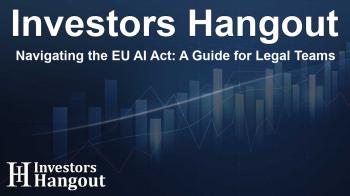Navigating the EU AI Act: A Guide for Legal Teams

Understanding the EU AI Act and Its Implications
In today's rapidly evolving technological landscape, the European Union has taken a groundbreaking step by introducing the AI Act. This regulation aims to create a robust framework governing the use of artificial intelligence across various sectors. As organizations strive to implement AI systems responsibly, a new guide from Hunton Andrews Kurth LLP serves as a beacon for legal and compliance teams navigating these waters.
What the AI Act Entails
The AI Act represents the first coherent set of rules specifically designed for artificial intelligence applications. It recognizes the transformative potential of AI while emphasizing the need for safeguarding fundamental rights and ensuring security. The guide published by Hunton outlines the key elements of this regulation, helping businesses grasp the scope and significance of the Act.
Types of AI Systems
One of the central aspects covered in the guide is the risk-based classification of AI systems. By providing decision trees for businesses, it enables them to identify the specific kind of AI technologies they are employing or developing. Understanding the classification is crucial, as it determines the compliance measures that organizations must adopt to align with the regulatory requirements.
Provider and Deployer Obligations
The guide presents practical advice for organizations categorized as providers or deployers of AI systems. For providers, who are responsible for placing AI solutions in the market, the guide delineates essential steps to ensure compliance in areas such as risk management and ethical implementation. Deployers, or those utilizing AI within their operations, also gain insight into their responsibilities and the importance of human oversight in AI usage.
Compliance Monitoring and Penalties
Adhering to the AI Act may involve rigorous scrutiny. The guide details how compliance will be monitored by EU and national authorities through market surveillance and regulatory frameworks such as sandboxes. It highlights the critical role of the AI Office in overseeing enforcement at the EU level while illustrating the consequences of non-compliance, which can include significant fines.
Looking Ahead: Preparing for Compliance
As the timeline for compliance unfolds between 2025 and 2027, organizations must proactively assess and adapt their AI strategies. Lisa Sotto, a leading figure in Hunton’s Privacy and Cybersecurity practice, emphasizes the necessity of integrating compliance into AI development processes. By breaking down complex regulations into achievable steps, the guide empowers organizations to build ethical and compliant AI systems that can thrive in an evolving regulatory landscape.
About Hunton Andrews Kurth LLP
For over a century, Hunton Andrews Kurth has built a legacy of excellence, serving clients worldwide with a collaborative spirit. With a strong foothold in various industries, including technology, real estate, and financial services, the firm is dedicated to addressing the complexities of modern legal challenges. The culture at Hunton is deeply rooted in commitment to client success, fostering a strong community in the legal field.
Frequently Asked Questions
What is the primary purpose of the EU AI Act?
The EU AI Act establishes a regulatory framework to ensure the safe and ethical use of artificial intelligence across industries, promoting user protection and compliance.
How does the guide from Hunton help organizations?
The guide provides detailed insights into regulatory requirements, offering practical steps for compliance tailored to the specific roles of providers and deployers of AI systems.
What are the consequences of not complying with the AI Act?
Organizations that fail to comply with the AI Act risk facing significant penalties, including financial fines and other regulatory actions.
When is the compliance timeline for the AI Act?
The compliance timeline for the AI Act is set to span from 2025 to 2027, with specific obligations rolling out at different intervals.
Who can benefit from the AI Act Guide?
Legal and compliance teams within organizations that utilize AI technologies can benefit from the guide, as it clarifies regulatory obligations and compliance strategies.
About The Author
Contact Caleb Price privately here. Or send an email with ATTN: Caleb Price as the subject to contact@investorshangout.com.
About Investors Hangout
Investors Hangout is a leading online stock forum for financial discussion and learning, offering a wide range of free tools and resources. It draws in traders of all levels, who exchange market knowledge, investigate trading tactics, and keep an eye on industry developments in real time. Featuring financial articles, stock message boards, quotes, charts, company profiles, and live news updates. Through cooperative learning and a wealth of informational resources, it helps users from novices creating their first portfolios to experts honing their techniques. Join Investors Hangout today: https://investorshangout.com/
The content of this article is based on factual, publicly available information and does not represent legal, financial, or investment advice. Investors Hangout does not offer financial advice, and the author is not a licensed financial advisor. Consult a qualified advisor before making any financial or investment decisions based on this article. This article should not be considered advice to purchase, sell, or hold any securities or other investments. If any of the material provided here is inaccurate, please contact us for corrections.

